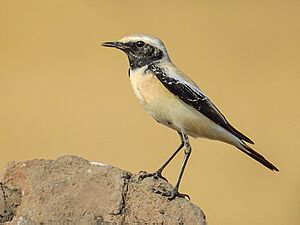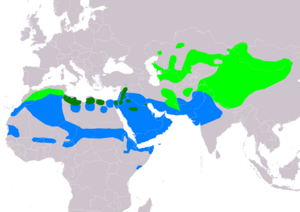Desert wheatear facts for kids
Quick facts for kids Desert wheatear |
|
|---|---|
 |
|
| Adult male Oenanthe deserti | |
| Conservation status | |
| Scientific classification | |
 |
|
| Range of O. deserti Breeding Resident Non-breeding |
The desert wheatear (Oenanthe deserti) is a small bird that lives in deserts and dry areas. It's known for its beautiful colors and how it moves. This bird is a type of wheatear, which are small passerine birds. They used to be thought of as part of the thrush family, but now scientists mostly agree they belong to the Old World flycatcher family.
Desert wheatears are migratory birds, meaning they travel long distances. They eat mostly insects. These birds are about 14.5 to 15 centimeters (around 6 inches) long. You can find them in places like the Sahara desert and the Arabian peninsula. Some types also live in the dry areas of Central Asia. In winter, they fly to warmer places like Pakistan and parts of northeast Africa.
Contents
What Does a Desert Wheatear Look Like?
The male desert wheatear has buff-colored feathers on its back and white feathers underneath. It has a black face and throat, which extends to its shoulders. There's also a clear white stripe above its eye. The female is a bit different; she's more grey on top and buff underneath, and she doesn't have the black throat.
A cool way to tell them apart, no matter their age or gender, is by their tail. The entire tail of a desert wheatear is black, right up to where it meets the body. This is a special feature that helps identify them.
Detailed Appearance
The adult male's head and neck are a light sandy-grey. Its back and shoulders are a similar but richer color. The feathers near its tail are pale buff. The tail feathers are white at the base and black for the rest of their length, with a pale buff tip. A curved stripe above the eye is pale buff. The chin, throat, and cheeks are black with white tips. Its chest and sides are sandy-buff, and its belly is creamy-white.
The female desert wheatear looks similar to the male but has more sandy-brown feathers near her tail. Her cheeks, chin, and throat are pale buff, and the dark parts of her tail are brownish-black. Young birds look like the adult female but have speckled feathers on their upper bodies. Desert wheatears are about 15 centimeters (6 inches) long and weigh between 15 and 34 grams. Their beak, legs, and feet are black, and their eyes are dark brown.
Where Do Desert Wheatears Live?
Desert wheatears live in a wide area, from the Middle East and Saudi Arabia, through Iran, Afghanistan, and into Mongolia. These birds fly south to spend the winter in northeast Africa, the Arabian peninsula, Iraq, and Pakistan. Another group lives in North Africa, from Morocco to Egypt. Most of these birds stay in their homes all year, but some from Morocco do migrate.
These birds love open, dry places. Their homes include deserts, semi-dry plains, salt flats, and rocky areas. You can find them at high altitudes, up to 3,500 meters (about 11,500 feet) above sea level. In winter, they might visit farmland if it has open, bare areas nearby.
Sometimes, a desert wheatear gets lost during its migration and ends up in places like the United Kingdom. This is rare, but it shows how far these birds can travel!
Life and Behavior
Desert wheatears mostly eat insects. They often sit on a bush or a small hill, then quickly fly down to catch insects on the ground. They can also catch insects in the air. Their diet usually includes ants, beetles, caterpillars, and flies. They also eat the larvae (young forms) of various insects, like ant-lions. Sometimes, they even eat seeds. If they find a large insect that's too big to handle, they might flutter their wings in front of it.
Reproduction and Nesting
Desert wheatears usually breed in late April or May. They build their nests in rocky hillsides, sandy plains, or in cracks in walls or under rocks. The nest is often hidden behind bushes. It's a neat, cup-shaped nest made of grasses, moss, and stems, lined with fine roots, hairs, and sometimes small feathers.
A female desert wheatear usually lays four eggs, but sometimes five. The eggs are pale bluish with small rusty speckles, often forming a clear ring at the wider end. They are about 20.1 by 15 millimeters in size. The female mostly takes care of incubating the eggs. Once the chicks hatch, both parents help to feed and care for them.
Conservation Status
The desert wheatear has a very large area where it lives and breeds, covering almost 10 million square kilometers (about 3.9 million square miles). The number of these birds seems to be steady. Because of this, the bird is listed as being of least concern on the IUCN Red List of Threatened Species. This means they are not currently in danger of disappearing.
Images for kids






